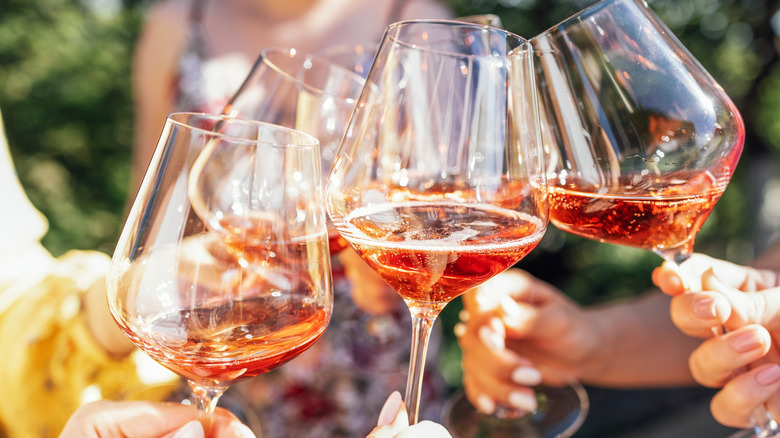The Right Way To Hold A Wine Glass For The Uninitiated
If you're new to wine, there's a lot to learn. It's exhilarating and exciting but sometimes confusing with all the talk of varietals, wine regions and their specific offerings, and topics like sulfites in wine. Then, there's the question of how to hold a wine glass. It may sound trivial to the uninitiated, but it matters if you want to experience the wine's flavors and other characteristics to their fullest extent.
To learn exactly how to hold a wine glass, Chowhound spoke to Maximilian Riedel, 11th-generation CEO and President of Riedel — The Wine Glass Company. According to Riedel, "The proper way to hold a stemmed wine glass is to clasp the stem between your thumb, pointer, and middle finger. You will then use your ring finger to hold the glass under the base."
If you pick up a glass and follow Riedel's guidance, you'll notice two things: It's easier to swirl the wine, a vital step for aeration, without it splashing out. You'll also find that your fingers are making the least possible contact with the glass's bowl. This is perhaps the most vital reason to hold your glass of vino with this finger positioning. As Riedel says, "It's best to hold the wine by the stem, as holding the bowl of the glass can, over time, warm the wine in the glass."
Why it's not ideal to let your wine get warm
The problem with warming is that wines are best enjoyed at a certain range of temperatures depending on their type. Red wines display their best properties at a few degrees below room temperature, while white wines should ideally be served at 49 to 55 degrees Fahrenheit. So any warmth transferred to the wine over a period of time — which can happen while leisurely savoring a glass's merits — can shift it into a temperature zone where its best traits aren't coming forward.
Common wine wisdom tends to prefer stemmed glasses for this reason, but as Maximilian Riedel explains, this isn't necessarily the only option when it comes to your glassware. Though he favors the stem grip, stemless glasses don't necessarily kill the temperature of wine — not if you're mindful of your hand positioning. He cautions, "I'd recommend less contact with the glass. But the Riedel 'O' series, one of our most popular collections, is a fantastic vessel for any quality wine."
All stemmed wine glasses can be held the same way
Beginners to the world of wine may wonder if there are differences in the optimal glass-holding technique among varietal-specific glassware. Red wine glasses tend to be larger than those for white wines, which typically have a shorter bowl to allow the nose to get closer to the lighter aromas. Then, there are Champagne glasses. These have their own range of shapes, from shallow-bowled coupes to tear-dropped tulips, to the slim, long flutes for celebratory toasts.
But despite the wide range of variations in bowl shapes and heights, Maximilian Riedel sees no reason to change up your grip for different glasses. He explains, "All stemmed wine glasses can be held the same to avoid warmth to the glass over time. It doesn't matter if it's a red, white, or Champagne glass, you'll want to clasp the stem for the best tasting experience."
That's great news for would-be oenophiles. Once you get your grip down, you'll be able to sip with the knowledge that you aren't doing anything to compromise the best characteristics of your wine.


